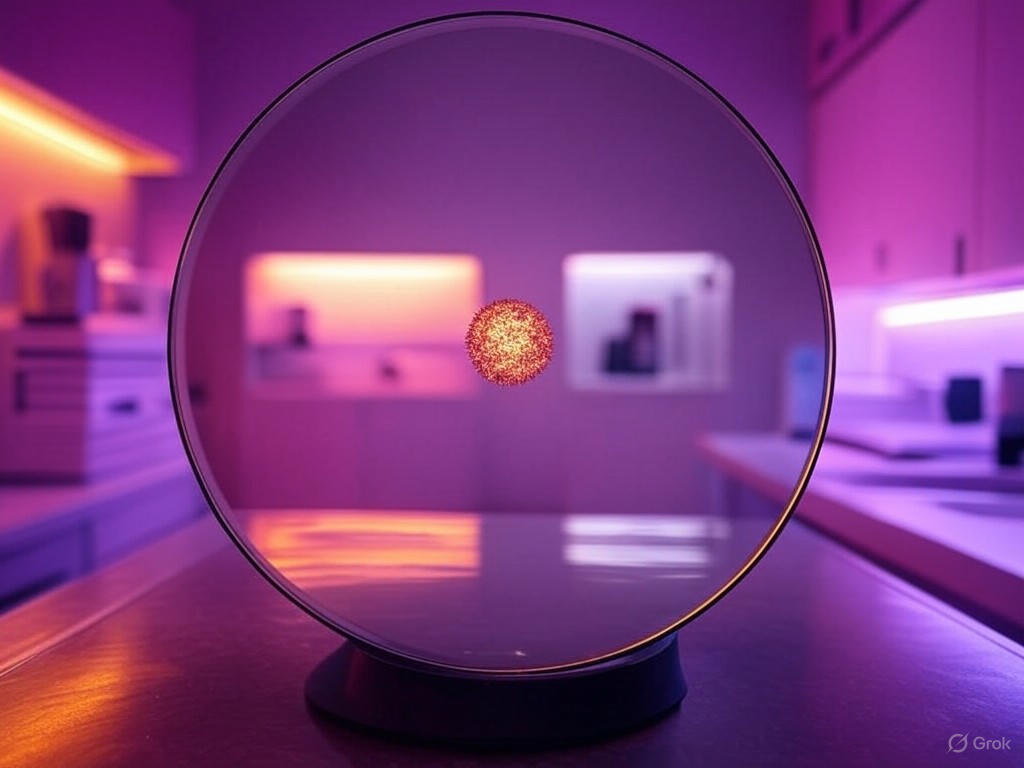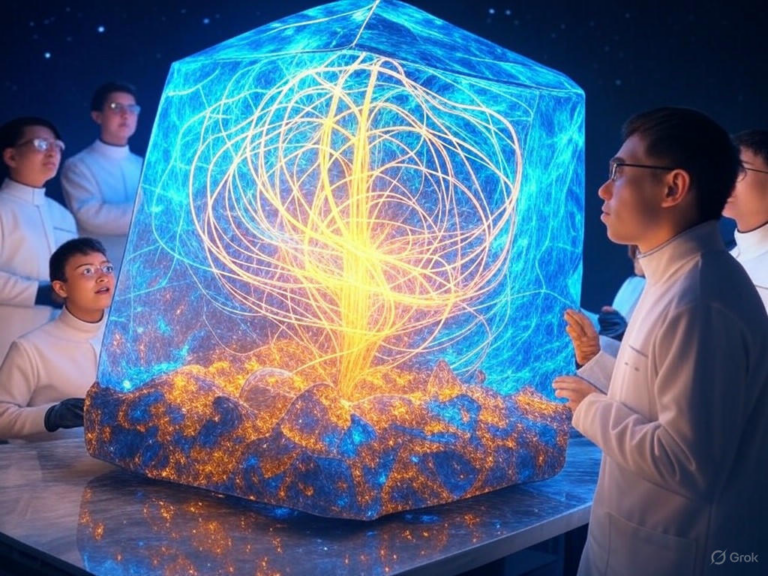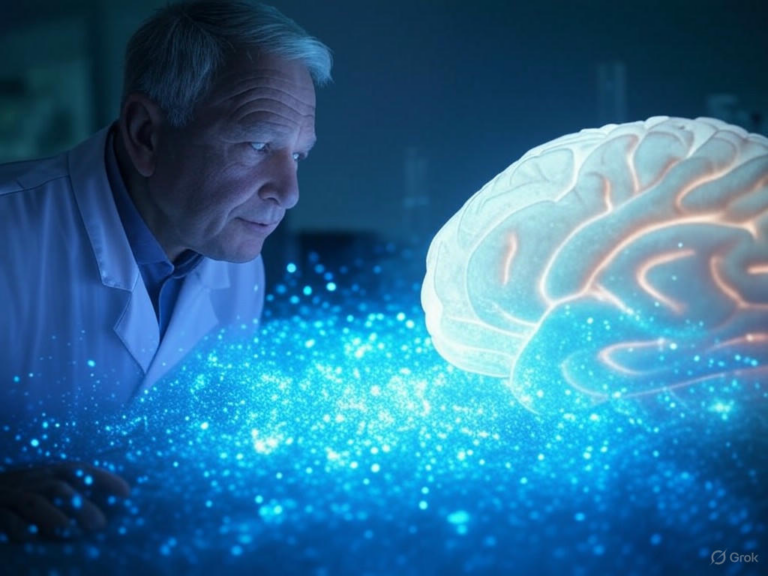
Quantum Noise Reduction Trick: Simple Mirror for Scientists
Revolutionary Quantum Noise Reduction Technique with a Simple Mirror
In the world of quantum physics, quantum noise reduction has just taken a surprising turn, thanks to a clever setup involving nothing more than a well-positioned mirror. Scientists at Swansea University have unveiled a method that slashes quantum noise by positioning a particle at the center of a hemispherical mirror, as detailed in a recent Physical Review Research paper. Imagine measuring tiny particles without the usual chaos—it’s like finally hearing a whisper in a crowded room.
This breakthrough minimizes the disruptive effects of quantum backaction, where light particles inevitably jostle the objects they’re observing. By creating perfect symmetry between the particle and its reflection, researchers have made quantum noise reduction not only possible but remarkably effective, opening doors to more accurate experiments. Have you ever wondered how we might probe the quantum world without altering it? This technique brings us closer to that reality.
Understanding the Quantum Measurement Challenge
At the heart of quantum noise reduction lies a classic puzzle: measuring minuscule objects like nanoparticles often disturbs them. When photons bounce off these particles, they impart momentum, creating quantum noise that muddles results. This quantum backaction has been a stubborn barrier, limiting how precisely we can observe quantum systems.
It’s akin to trying to weigh a feather on a windy day—the wind (or in this case, the measurement) keeps shifting things. Researchers have long accepted this as an inevitable trade-off, where gaining information means introducing disturbance. But what if we could flip the script? The Swansea team’s work shows that quantum noise reduction can turn this limitation on its head.
The Intricate Balance of Measurement and Disturbance
Traditional quantum theory suggests that the more you measure, the more you disrupt—think of it as eavesdropping on a conversation and accidentally joining in. Yet, as lead author Rafal Gajewski notes, if conditions make measurement impossible, quantum noise reduction kicks in, and disturbance vanishes.
This bidirectional relationship challenges old assumptions, offering a fresh perspective on quantum noise reduction. It’s not just about lessening noise; it’s about rethinking how we interact with quantum particles. Could this spark new ways to explore unseen quantum phenomena?
How the Mirror Enables Quantum Noise Reduction
The beauty of this quantum noise reduction trick lies in its simplicity: place a nanoparticle at the center of a hemispherical mirror, and watch the magic unfold. In this setup, the particle becomes indistinguishable from its mirror image, trapping scattered light in a way that yields no usable position data.
Without that information, quantum backaction doesn’t occur, effectively achieving quantum noise reduction. Picture a hall of mirrors at a fair—everything blends so perfectly that you lose track of what’s real. That’s essentially what’s happening here, but on a quantum scale.
Delving into the Quantum Noise Reduction Mechanics
Technically, this quantum noise reduction stems from the mirror’s geometry. By situating the particle at the mirror’s center of curvature, symmetry ensures that scattered photons carry no positional clues. This isn’t what we’d expect; usually, more scattering means more disturbance, but here it leads to cleaner measurements.
It’s a nuanced twist on quantum rules, where environmental design plays a starring role. For scientists, this means quantum noise reduction could become a go-to strategy for experiments that demand utmost precision. What might this mean for future tech, like quantum sensors that detect the faintest signals?
Exciting Applications of Quantum Noise Reduction
Quantum noise reduction isn’t just theoretical—it’s primed for real-world impact. This mirror-based method could help create quantum states with larger objects, pushing quantum effects beyond atomic scales and into everyday visibility.
From testing quantum principles with bigger systems to developing ultra-sensitive sensors, the possibilities are vast. Imagine using this for detecting tiny forces in medical devices or environmental monitoring—could quantum noise reduction revolutionize how we sense the world around us?
- Quantum Noise Reduction for Larger-Scale Experiments: Enabling quantum states in macroscopic objects, which might reveal new physics insights.
- Enhanced Quantum Measurements: Allowing tests at unprecedented scales, potentially bridging quantum mechanics and gravity.
- Precision Tools: Crafting sensors that pick up minute forces, vital for fields like astronomy or biology.
- Quantum-Gravity Explorations: Supporting experiments that probe fundamental questions about the universe.
- Space Ventures: Aiding missions like MAQRO, where quantum noise reduction could ensure reliable data from space.
Progress in Levitated Optomechanics and Quantum Noise Reduction
This innovation fits into levitated optomechanics, where lasers hold particles in mid-air for study. By incorporating quantum noise reduction, researchers gain finer control over these systems, minimizing disturbances.
It’s a step forward in a field that’s rapidly evolving, with parallels in other labs. For instance, MIT’s work on squeezing noise across frequencies complements this approach, broadening the scope of quantum noise reduction.
Related Advances in Quantum Noise Reduction Strategies
Scientists at Oak Ridge National Laboratory and the University of Maryland are combining techniques to push quantum noise reduction beyond current limits. Their efforts aim to create optomechanical sensors that operate below the standard quantum threshold.
These developments underscore a growing trend: quantum noise reduction is key to breakthroughs in areas like gravitational wave detection and quantum computing. It’s exciting to see how these pieces might fit together.
Broader Implications for Understanding Quantum Physics
Beyond practical uses, this quantum noise reduction technique deepens our grasp of quantum mechanics. It reveals that the link between information and disturbance is more flexible than we thought, influenced by how we shape the environment.
By tweaking mirror setups, scientists can control quantum noise, challenging established theories. This could inspire a rethink of quantum measurement, much like how GPS transformed navigation. What new questions might this raise about the quantum realm?
The Road Ahead for Quantum Experimentation and Noise Reduction
As quantum technologies mature, tools for quantum noise reduction like this mirror trick could become essential. They promise higher-fidelity quantum computing and more stable systems, accelerating progress in information processing.
In precision measurement, it might lead to detectors sensitive enough for spotting dark matter or gravitational waves. But challenges remain, such as refining materials to avoid losses that could undermine quantum noise reduction.
Overcoming Hurdles in Quantum Noise Reduction
Ongoing research focuses on perfecting mirror designs and adapting the technique to various particles. Combining it with other methods could amplify its benefits, making quantum noise reduction even more robust.
It’s a reminder that innovation often builds on iteration—much like software updates that fix bugs and add features. How might these refinements change the landscape of quantum science?
Wrapping Up: A Giant Step in Quantum Noise Reduction
The hemispherical mirror’s role in quantum noise reduction marks a pivotal moment, showing how a straightforward idea can reshape quantum physics. By eliminating quantum backaction, it not only aids experiments but also enriches our theoretical foundation.
As this method evolves, it could unlock answers to big questions, from quantum-gravity links to measurement boundaries. For anyone intrigued by science, this is a testament to human ingenuity—what seemed impossible might just be a clever mirror away.
If you’re as excited about this as I am, I’d love to hear your thoughts. Share your ideas in the comments, or check out our other posts on quantum innovations. Let’s keep the conversation going!
References
- Phys.org. “Hemispherical mirror technique results in quantum backaction vanishing completely.” Link
- Quantum Zeitgeist. “Breakthrough in quantum noise reduction using mirrors opens new possibilities for quantum experiments.” Link
- YouTube Video. “Quantum Noise Reduction Explained.” Link
- Bioengineer.org. “Quantum noise reduction: A major breakthrough unveiled.” Link
- Science Magazine. DOI: 10.1126/science.ado8069. Link
- ORNL. “Combining quantum noise reduction resources: A practical approach.” Link
- Stephen Goforth. “Artificial Intelligence and Quantum Physics.” Link
- MIT News. “Boosting quantum signals by squeezing noise.” Link
quantum noise reduction, hemispherical mirror, quantum backaction, Swansea University research, quantum measurement, quantum physics breakthrough, quantum experiments, levitated optomechanics, quantum sensors, quantum computing advancements







